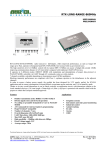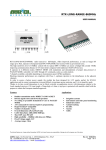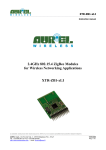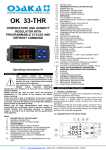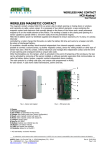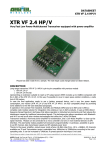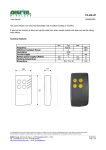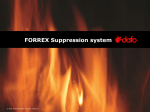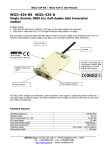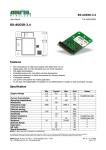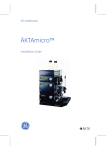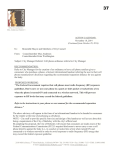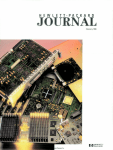Download user manual
Transcript
PRELIMINARY XTR-7020A-8 --------------------------------------------------------------------------------------------------------------------------------------------------- Owner’s Manual The XTR-7020A-8 is a 7 channel transceiver which compared with the XTR-903A-8, offers improved performance, as such as longer RF range, serial transmission speed and error checking. It has the same pin out. The data is transmitted in FSK modulation which assures a larger immunity to noise compared with amplitude modulation, allowing a range of more than 300 m in free air, by using omnidirectional antennas. The XTR-7020A-8 allows data transfer by TTL RS-232 logic by utilising a microcontroller which operates the redundance over the RF data. The speed of the data at the input serial port (9600-19200-38400 bps and 9600-57600-115200 bps according to S5 register setting) can be set through SP1 and SP2 pins. The data transmission is carried out according to store and forward technique: the data entered the serial port is memorized in a buffer and forwarded only at the end of their reception. During RF reception phase the bytes are memorized and transferred to the serial port only after checksum validation. In case of failure the whole lot is rejected. The data transmission delay (between input and output ports), depends upon packet length and speed of both serial connections. The high serial speeds (57600-115200bps) available, allows compensation of the introduced packaging delays: for instance a 64 Byte case, at a serial speed of 115200bps, the transmission delay shall be around 18ms, which is comparable, therefore, to XTR-903A-8. The maximum packet length is 240 Byte. By sending ‘AT’ type commands the communication channel, the serial speed and the outlet power can be selected and the RF channel occupation be monitored. The module is mechanicaly compact and maintains the same reduced dimensions of the XTR-903A-8 model (23 x 33 mm). The supply voltage is 3 Volt. The maximum power consumption is reduced to 20 µA. in stand-by condition Features RS-232 signals store and forward operation No code or preamble demanded to User AT Commands for internal registers programming HyperTerminal* compatible Number of channels: 7 Compact dimensions (23x33 mm) Bit rate: 9600, 19200, 38400, 57600, 115200 bps Power transmitted: 10 mW max. 3v power supply Typical range: 300 m Applications Wireless handsfree House automation Telemetry Access control Instruments monitoring Data acquisition POS terminals * Trade Mark by Hilgraeve, Inc.. Technical specifications may be changed without notice. AUR°EL S.p.A. declines all responsabilities deriving from a wrong utilisation of the equipment. --------------------------------------------------------------------------------------------------------------------------------------------------------------------AUR°EL S.p.A. Via Foro dei Tigli, 4 - 47015 Modigliana (FC) – ITALY 13/06/2008 Pag 1 of 13 Tel.: +39.0546.941124 Fax: +39.0546.941660 http://www.aurelwireless.com - email: [email protected] PRELIMINARY XTR-7020A-8 --------------------------------------------------------------------------------------------------------------------------------------------------- Owner’s Manual Absolute limits Operating temperature Storage temperature Power supply Input voltage Output voltage -20 °C ÷ +70 °C -40 °C ÷ +100 °C +6V -1.0 ÷ Vcc + 0.3V -1.0 ÷ Vcc + 0.3V Technical features DC Levels Supply voltage Power consumption (rx mode) Power consumption (tx mode @ -8 dBm) Power consumption (tx mode @ 10 dBm) Power consumption (stand-by mode) Logic level “1” in input/output Logic level “0” in input/output RF Band Modulation type RX Sensibility (@115200 bps) TX Power Performance Serial Bit Rate 1 Outdoor range Number of channels Channel Spacing Commutation times PWRDN → RX TX → RX RX → TX Default setting Channel Output Power (tx) 1 Min. Typ. Max. Unit 2.7 3.3 26 20 31 18 3.6 V mA mA mA µA V V 0.7xVcc 0 20 Vcc 0.3xVcc MHz 868÷870 FSK -100 -8 10 dBm dBm 9600, 19200, 38400, 57600, 115200 300 7 153.6 kHz <5 <5 <5 ms ms ms 868.19 MHz dBm 10 bps m As input serial signal is intended 8,n,1. Technical specifications may be changed without notice. AUR°EL S.p.A. declines all responsabilities deriving from a wrong utilisation of the equipment. --------------------------------------------------------------------------------------------------------------------------------------------------------------------AUR°EL S.p.A. Via Foro dei Tigli, 4 - 47015 Modigliana (FC) – ITALY 13/06/2008 Pag 2 of 13 Tel.: +39.0546.941124 Fax: +39.0546.941660 http://www.aurelwireless.com - email: [email protected] PRELIMINARY XTR-7020A-8 --------------------------------------------------------------------------------------------------------------------------------------------------- Owner’s Manual Pins description XTR-7020A-8 Fig. 1: Device’s pinout Pin 1,3 2 4, 5, 6, 7, 8 9,10,18 11,15 Description RF GND ANT / Connection with RF ground plane GND SP1, SP2 Connection to ground plane Antenna connection, 50 ohm impedance Not in use in this model Serial speed selection pins. The selection must be carried out before switching on the device Jumper S1 Vcc Gnd Vcc Gnd S2 Gnd Vcc Vcc Gnd Serial speed S5=0 S5=1 38400 115200 19200 57600 9600 9600 Test Mode: Test Mode : pseudonoise data packet 12 RSRX Serial data output with TTL RS-232 logic with 1 start bit (0V), 8 data bit and 1 stop bit (3V). The line must be driven at high logic level (3V) 13 485EN/CTS Pin 13 could be programmed by registers S6 and S7. In this way a transceiver RS485 could be enabled or close the data transmission upon the serial line (CTS) The 485EN line allows to drive the RS-232 / RS-485 interface. In correspondence of the output data on the RSTX line, the signal reches a high logic level. CTS signal is driver in a lower logic signal when unit connected to the RSTX line doesn’t transmitt any data. XTR 7020A-8 connection components are busy in previous sending operations. 14 RSTX Serial data input with TTL RS-232 logic with 1 start bit (0V), 8 data bit and 1 stop bit (3V). The line must be driven at high logic level. 16 PWRDN Device state. In Power Down the transceiver XTR-7020A-4 goes off reducing the consumption to less than 20µA. PWRDN 0 1 STATE On Off Technical specifications may be changed without notice. AUR°EL S.p.A. declines all responsabilities deriving from a wrong utilisation of the equipment. --------------------------------------------------------------------------------------------------------------------------------------------------------------------AUR°EL S.p.A. Via Foro dei Tigli, 4 - 47015 Modigliana (FC) – ITALY 13/06/2008 Pag 3 of 13 Tel.: +39.0546.941124 Fax: +39.0546.941660 http://www.aurelwireless.com - email: [email protected] PRELIMINARY XTR-7020A-8 --------------------------------------------------------------------------------------------------------------------------------------------------- Owner’s Manual It is recommended not to leave the pin under a variable voltage if inactive, in order to avoid module’s malfunctionings 17 Vcc Module’s supply (3V), duly filtered and adjusted. Tab. 1: Pins description XTR-7020A-8 Operating mode The device’s operating modes can be summarized in 6 conditions (Fig. 2): RF Transmit Mode 1. Test Mode 2. Idle Mode 3. RF Transmit Mode 4. RF Receive Mode Power Down Mode Idle Mode RF Receive Mode 5. Power Down Mode 6. Command Mode Test Mode Command Mode Fig. 2 Operating modes 1. Test Mode The Test Mode can be reached by short circuiting pins SP1 and SP2 to ground, prior to switching on the device. According to S5 register containt, two different test modes can be obtained: • S5=0: An RF continuous transmission of a carrier madulated by a 20 kHz signal composed by a sequence of pseudorandom data. • S5=1: Transmission of a data packet defined by a 4 digits incremental numerical value. To exit such mode the supply must be cut off and a new configuration of SP1 and SP2 must be selected. 2. Idle Mode It is the initial rest state of the device when is switched on (if SP1 and SP2 select the Test Mode): in such operating mode the transceiver waits the data reception from RF or from the RSTX serial line. Technical specifications may be changed without notice. AUR°EL S.p.A. declines all responsabilities deriving from a wrong utilisation of the equipment. --------------------------------------------------------------------------------------------------------------------------------------------------------------------AUR°EL S.p.A. Via Foro dei Tigli, 4 - 47015 Modigliana (FC) – ITALY 13/06/2008 Pag 4 of 13 Tel.: +39.0546.941124 Fax: +39.0546.941660 http://www.aurelwireless.com - email: [email protected] PRELIMINARY XTR-7020A-8 --------------------------------------------------------------------------------------------------------------------------------------------------- Owner’s Manual 3. RF Transmit Mode From the inactive condition (Idle Mode) the module switches to an RF transmission state, when on the RSTX input line (pin 14) is available a start bit (low logic level, 0V) and consequently at list one byte of data. The mechanism of data transfer Store & Forward may be described by pairs of operations in a sequence. Unit A serial reception / Unit A RF transmission Unit B RF reception / Unit B serial transmission [Fig. 3] The lack of data at the XTR-7020A-8 module’s input is established by the expiring of a Timeout (determined according to the speed of the data serial). Once it is off, the transceiver does not memorize further incoming data until the RF transmission, of those already inside its reception buffer, is carried out. The data is transmitted through an RF channel only after the serial reception is over. In the same way the receiver analyzes the received packets from the RF, proceeding then with the serial transmission if the data is valid or discarding them if not correct. Unit A serial reception Unit A serial STORE Unit A RF FORWARD Unit A RF transmission Radiofrequency Valid packet from unit B and transmitted through serial port Unit B RF reception Unit B RF STORE Unit B serial FORWARD Unit B serial transmission 0 t [ms] Fig. 3: Store & Forward mechanism As shown by the Fig. 3 time diagram, the time interval, from the starting moment (instant 0) when the data reaches the module’s port, to the moment when it is received by the remote module, is the function of the number of Bytes that form the packet and of the serial speeds used for the reception as well as for the transmission. Technical specifications may be changed without notice. AUR°EL S.p.A. declines all responsabilities deriving from a wrong utilisation of the equipment. --------------------------------------------------------------------------------------------------------------------------------------------------------------------AUR°EL S.p.A. Via Foro dei Tigli, 4 - 47015 Modigliana (FC) – ITALY 13/06/2008 Pag 5 of 13 Tel.: +39.0546.941124 Fax: +39.0546.941660 http://www.aurelwireless.com - email: [email protected] PRELIMINARY XTR-7020A-8 --------------------------------------------------------------------------------------------------------------------------------------------------- Owner’s Manual For the correct operation of the device consider that the phases contemporaneity inside the same unit is not allowed; for instance : the data that possibly has entered through serial port of unit A is not memorized in the input buffer if the same unit is in RF transmission phase. Same thing for unit B; it is not allowed to receive RF data while the previous bytes packet is under serial transmission. Fig. 4 shows the case of the transmission of two packets in a sequence from unit A to unit B: packet #1 enters unit A and is transmitted to unit B that forwards it through the serial port. The transmission of the packet #2 must be carried out bearing in mind that the end of the serial reception of unit A has to take place AFTER the end of the serial transmission of packet #1 by unit B so to avoid the overlapping of the RF reception and of the serial transmission phases in this device: it is therefore necessary to enter a safety interval between the transmissions of the two packets in function of the number of byte of the first packet, of the serial speed of unit B and in function of the time required TRF [ms ] for the transmission of the packet on the RF which depends upon the number of bytes of the packet and it is given by TRF [ms ] = 3.1 + 0.139 ⋅ N byte Unit A The last byte of the second packet must enter unit A after unit B has ended the serial transmission of the first packet . Serial data cannot be sent to unit A while the RF transmission of the packet #1 is in progress. serial reception packet #1 Packet #2 cannot enter unit A while the RF transmission of packet #1 is in progress. Unit A Unit A serial reception of packet #2 RF transmission of packet #1 Unit B serial transmission of packet #1 t [ms] 0 Fig. 4: Two data packets transmission 5. Power Down Mode By bringing to high level (+3V) pin 16 (PWRDN), the device enters into a power saving state; the consumption in fact is limited to less than 10 µA. In this mode, the transceiver can neither receive nor transmit. It is necessary to commutate pin 16 to low level (0V) to bring it back to the normal operating state (Idle mode). In such a state the RSTX line must be maitained to the high logic level (+3V) to avoid a wrong data transmission when the module is switched on. 6. Command Mode (XTR-7020A-8) Technical specifications may be changed without notice. AUR°EL S.p.A. declines all responsabilities deriving from a wrong utilisation of the equipment. --------------------------------------------------------------------------------------------------------------------------------------------------------------------AUR°EL S.p.A. Via Foro dei Tigli, 4 - 47015 Modigliana (FC) – ITALY 13/06/2008 Pag 6 of 13 Tel.: +39.0546.941124 Fax: +39.0546.941660 http://www.aurelwireless.com - email: [email protected] PRELIMINARY XTR-7020A-8 --------------------------------------------------------------------------------------------------------------------------------------------------- Owner’s Manual The Command Mode state allows the Owner to configure the operating parameters of the device. The programming is carried out by means of ‘AT’ type commands sent to the RSTX line (pin 14) at the speed set by means of pins SP1 and SP2 (pin 11 and 15). The module’s answers shall be given on the RSRX line (pin 12). To enter Command Mode from Idle Mode it is necessary to send on the RSTX line (pin 14) a sequence of 3 consecutives ASCII characters ‘+’, i.e.: (+++). A module under Command Mode state is unabled to RF reception. Available Registers and Commands The commands that can be issued to XTR-7020A-8 module concern the reading and writing of the registers containing the operation setting of the device. The reading and writing of the configuration register and the sending of the commands to the module is carried out by entering the ’AT’ sequence before the command’s or register’s name. The 16 programmable registers (from S1 to S16) can be read or written according to their function. Register Name R/W BAND Function Operating band of the transceiver Values S1 0 = 868-870 MHz * R S2 CHANNEL Operating channel 0 = 868,19 MHz 3 * 1 = 868,34 MHz 2 = 868,49 MHz 4 = 868,80 MHz 5 = 868,95 MHz 6 = 869,11 MHz 11 = 869,87 MHz 3 R/W S3 POWER Device’s output power level 0 = - 8 dBm 1 = - 2 dBm 2 = + 4 dBm 3 = + 10 dBm * R/W S4 RFON It switches On or OFF the module’s transmission power 0 = Power RF ON * 1 = Power RF OFF R/W S5 SER Selection of the serial speeds’ two benches 0= ‘slow’ bench* 1= ‘fast’ bench R/W S6 CTS Selection on PIN 13 from 485 EN and CTS 0=485EN* 1=CTS R S7 SPD In the XTR-7020A-8 upstream of adio trafficking, 0=9600* set the speed of the serial downstream so as to 1=19200 manage the activities of the pin 13 when mode CTS R S15 VERSION Code showing the firmware version Variable R S16 RSSI It supplies a digital indication of the power received level, with a gradual scale from 0 to 9 0 = Min power received 9 = Max power received R 3 * = default values Command Name WR WRITE CC COMMAND CLOSE = Channel not to be used with max power Function Writing of the registers’ values in EEPROM Command Mode exit Tab. 3: commands Technical specifications may be changed without notice. AUR°EL S.p.A. declines all responsabilities deriving from a wrong utilisation of the equipment. --------------------------------------------------------------------------------------------------------------------------------------------------------------------AUR°EL S.p.A. Via Foro dei Tigli, 4 - 47015 Modigliana (FC) – ITALY 13/06/2008 Pag 7 of 13 Tel.: +39.0546.941124 Fax: +39.0546.941660 http://www.aurelwireless.com - email: [email protected] PRELIMINARY XTR-7020A-8 --------------------------------------------------------------------------------------------------------------------------------------------------- Owner’s Manual Records s6 and s7 and CTS signal When the module XTR-7020A-8 is set to CTS (S6 register programmed to 1), Pin 13 maintain an high logical level and becomes low when the unit begins to transmit data on RF. The signal remains low for a time calculated on the basis of the alleged serial speed which is programmed the form XTR-7020A-8 related traffic downstream (selectable via the register S7) and the number of Bytes forming the data packet. In this way, reading the signal CTS, the unit linked upstream of the first XTR-7020A-8 will decide to don’t submit data on the serial line as the XTR-7020A-8 in reception is used in the serial transmission of previous data packet. The use of the register S16 The reading of the register S16 involves the activation of a procedure for analysis of RF channel where module is programmed. This routine has set a duration of about 200ms. The result of the analysis is provided at the end of the operation. No other operation must be performed during this interval. Channel analysis can be performed for determine if channel is busy, and for checking the receiving quality, and to verify the quality of reception in case you want to test the quality of a connection that is planning. Answers to commands and operations on registers Positive answer: OK<CR><LF> Negative answer: <bl> ERROR<CR><LF> Forbidden operation: <bl> NO ACCESS<CR><LF> With <CR> Carriage Return, ASCII character 13; <LF> Line Feed, ASCII character 10; <bl> ASCII character 32. Reading of a register Syntax: ATSx<CR><LF> [x = 1, ...,16 register to be read] Answer : value contained in the register if the command has been correctly issued followed by <CR><LF>. The registers’ value is returned, figure by figure, under ASCII value. Example: ‘16’ is the sequence of ASCII codes 0x31,0x36, corresponding precisely to figure ‘1’ and ‘6’. Such interpretation procedure must be followed even for the writing of a register’s value. Writing of a register Syntax: Answer: ATSx=Y<CR><LF> [x = 2, 3, 4 register to be written, y = value to be entered] as indicated to ‘Answers to commands’ above All values programmed in the registers cause a variation of the module’s operating conditions that will be lost once the device is switched off, unless they are saved in the EEPROM memory of the microcontroller by means of the relevant command ATWR: in such case the modified values shall be active also to subsequent switching on. Technical specifications may be changed without notice. AUR°EL S.p.A. declines all responsabilities deriving from a wrong utilisation of the equipment. --------------------------------------------------------------------------------------------------------------------------------------------------------------------AUR°EL S.p.A. Via Foro dei Tigli, 4 - 47015 Modigliana (FC) – ITALY 13/06/2008 Pag 8 of 13 Tel.: +39.0546.941124 Fax: +39.0546.941660 http://www.aurelwireless.com - email: [email protected] PRELIMINARY XTR-7020A-8 --------------------------------------------------------------------------------------------------------------------------------------------------- Owner’s Manual Command to save the registers’ value in EEPROM Syntax: Answer: ATWR<CR><LF> as indicated to para ‘Answers to commands’ above Exit command from Command Mode Syntax: ATCC<CR><LF> Answer: as indicated to para ‘Answers to commands’ above The exit from Command Mode, in absence of the ATCC command, takes place automatically after approx. 5 seconds of inactivity. Operations It is possible to chain several operations by mixing actions on one single register and writing or exit commands on a single command line through the operator <,>. In the following example the S3 register’s value is set to 2, the modification is saved and the programming function is quitted: Example #1: Writing of a register and value save. Exit from Command Mode ATS3=2,WR,CC <CR><LF> OK<CR><LF> As it can be seen from the example, the prefix AT is applied only for the first command of the line, while for the subsequents must be skipped. The commands chaining is possible only on one register at a time for writing operations; if carried out along with a reading command it will engender an error answer. Example #2: Register reading attempt and exit from Command Mode If it is attempted to enter the command ATS1,CC<CR><LF> it will be realized that is not possible and that the module will indicate an error when the coma is typed. The screen shall display what follows: ATS1,<bl> ERROR<CR><LF> The commands are not case sensitive therefore can be typed in upper or lower-case. See Appendix A for further examples. Application Examples Fig. 5 shows a typical application of the XTR-7020A-8 connected to a microcontroller that, besides to receive and transmit data on the two input and output lines (RSTX and RSRX), it drives also the PWRDN. Technical specifications may be changed without notice. AUR°EL S.p.A. declines all responsabilities deriving from a wrong utilisation of the equipment. --------------------------------------------------------------------------------------------------------------------------------------------------------------------AUR°EL S.p.A. Via Foro dei Tigli, 4 - 47015 Modigliana (FC) – ITALY 13/06/2008 Pag 9 of 13 Tel.: +39.0546.941124 Fax: +39.0546.941660 http://www.aurelwireless.com - email: [email protected] PRELIMINARY XTR-7020A-8 --------------------------------------------------------------------------------------------------------------------------------------------------- Owner’s Manual Vc Microcontroll 1 RF 2 3 RF XTR- GND Vcc PWRDN SP2 TXD OUT OUT RXD SP1 GND 9 IN Fig. 5: Example of a 9600 bps connection (SP1 and SP2 to Vcc) between a XTR-7020A-8 and a microcontroller Fig. 6 shows an example of connection between an XTR-7020A-8 module and the serial port of a PC: the integrated circuit interposed between the transceiver and the port, performs only the conversion function between the electrical levels of the RS-232 and the TTL logic. By means of the RTS signal (pin 7 of the DB9 port) it is possible to drive the PWRDN line, while the serial speed selection is fixed to 9600 bps. Vcc 1 RF GND 2 Antenna 3 RF GND 9 GND GND 18 Vcc 17 PWRDN 16 SP2 15 TXD 14 XTR-7020A-8 RXD 12 SP1 11 GND 10 MAX-232 9 R2OUT R1IN 13 12 R1OUT R2IN 8 T2OUT 7 10 T2IN DB9 Fig. 6: Example of the connection between an XTR-7020A-8 and the serial port RS-232 at 9600 bps (SP1 and SP2 to Vcc) Technical specifications may be changed without notice. AUR°EL S.p.A. declines all responsabilities deriving from a wrong utilisation of the equipment. --------------------------------------------------------------------------------------------------------------------------------------------------------------------AUR°EL S.p.A. Via Foro dei Tigli, 4 - 47015 Modigliana (FC) – ITALY 13/06/2008 Pag 10 of 13 Tel.: +39.0546.941124 Fax: +39.0546.941660 http://www.aurelwireless.com - email: [email protected] PRELIMINARY XTR-7020A-8 --------------------------------------------------------------------------------------------------------------------------------------------------- Owner’s Manual Standards of reference The XTR-7020A-8 transceiver complies with European Standards EN 300 220, and EN 301 489. The tests are carried out transmitting and receiving Pseudo Random (CEPT 70-03) Codes. The occupation band is verified by using a Pseudo Random Code at 115200 bps. Besides, the product has been tested according to EN 60950 Standards and it is utilized inside a special isolated case which guarantees its compliance to the above mentioned Standards. The transceiver must be fed by a very low voltage and safety source protected against short circuits. The usage of the transceiver module is foreseen inside cases that guarantee the compliance to EN 61000-4-2 Standards not directly appliable to the module itself. In particular, is left to user’s care the isolation of the connection to the outdoor antenna and of the antenna itself since the RF output of the receiver is not in the position to directly bear the electrostatic charges foreseen by the a.m. standards. CEPT 70-03 Reccommendation The XTR-7020A-8 transceiver operates in a harmonized frequency band therefore, in order to comply with the current regulations; the device must be utilized in the time scale, for a maximum hourly duty-cycle less then one specified on CEPT 70-03 Reccommendation. The antenna suggested solution (loop antenna) guarantees the compliance with the regulation concerning the irradiated power. Mechanical dimensions Fig. 7: Mechanical dimensions Technical specifications may be changed without notice. AUR°EL S.p.A. declines all responsabilities deriving from a wrong utilisation of the equipment. --------------------------------------------------------------------------------------------------------------------------------------------------------------------AUR°EL S.p.A. Via Foro dei Tigli, 4 - 47015 Modigliana (FC) – ITALY 13/06/2008 Pag 11 of 13 Tel.: +39.0546.941124 Fax: +39.0546.941660 http://www.aurelwireless.com - email: [email protected] PRELIMINARY XTR-7020A-8 --------------------------------------------------------------------------------------------------------------------------------------------------- Owner’s Manual Appendix A – More examples of operations with registers Example #3: reading of the module’s operating band +++OK <CR><LF> ATS1 <CR><LF> 0 <CR><LF> [0= 433-434 MHz band] Example #4: variation of the module’s operating band +++OK <CR><LF> ATS1=2 <CR<LF> <bl> NO ACCESS<CR><LF> Syntax error: the S1 register is available for reading only Example #5: Channel reading +++OK <CR><LF> ATS2 <CR><LF> 2 <CR><LF> [2= 433.5 MHz channel] Example #6: Channel selection +++OK <CR><LF> ATS2=8 <CR><LF> OK <CR><LF> [8= 434,42 MHz channel] Example #7: Output power reding +++OK <CR><LF> ATS3 <CR><LF> 1 <CR><LF> [1= power –2dBm] Example #8: Output power selection +++OK <CR><LF> Technical specifications may be changed without notice. AUR°EL S.p.A. declines all responsabilities deriving from a wrong utilisation of the equipment. --------------------------------------------------------------------------------------------------------------------------------------------------------------------AUR°EL S.p.A. Via Foro dei Tigli, 4 - 47015 Modigliana (FC) – ITALY 13/06/2008 Pag 12 of 13 Tel.: +39.0546.941124 Fax: +39.0546.941660 http://www.aurelwireless.com - email: [email protected] PRELIMINARY XTR-7020A-8 --------------------------------------------------------------------------------------------------------------------------------------------------- Owner’s Manual ATS2=3 <CR><LF> OK <CR><LF> [3= power +10dBm] Example #9: Reading of the received signal +++OK <CR><LF> ATS16 <CR><LF> 9 <CR><LF> [9 = busy channel, maximum received power] Example #10: Reading of the received signal +++OK <CR><LF> ATS16 <CR><LF> 0 <CR><LF> [free channel, minimum received power] Technical specifications may be changed without notice. AUR°EL S.p.A. declines all responsabilities deriving from a wrong utilisation of the equipment. --------------------------------------------------------------------------------------------------------------------------------------------------------------------AUR°EL S.p.A. Via Foro dei Tigli, 4 - 47015 Modigliana (FC) – ITALY 13/06/2008 Pag 13 of 13 Tel.: +39.0546.941124 Fax: +39.0546.941660 http://www.aurelwireless.com - email: [email protected]















